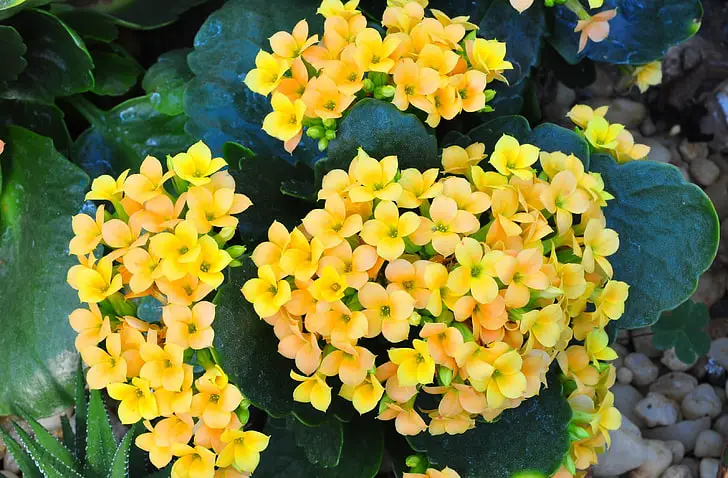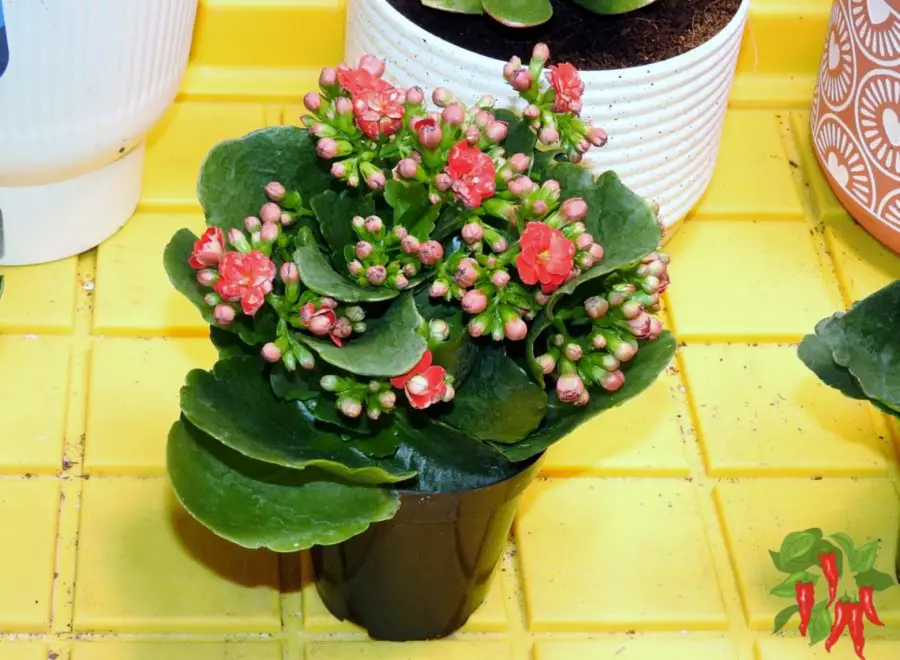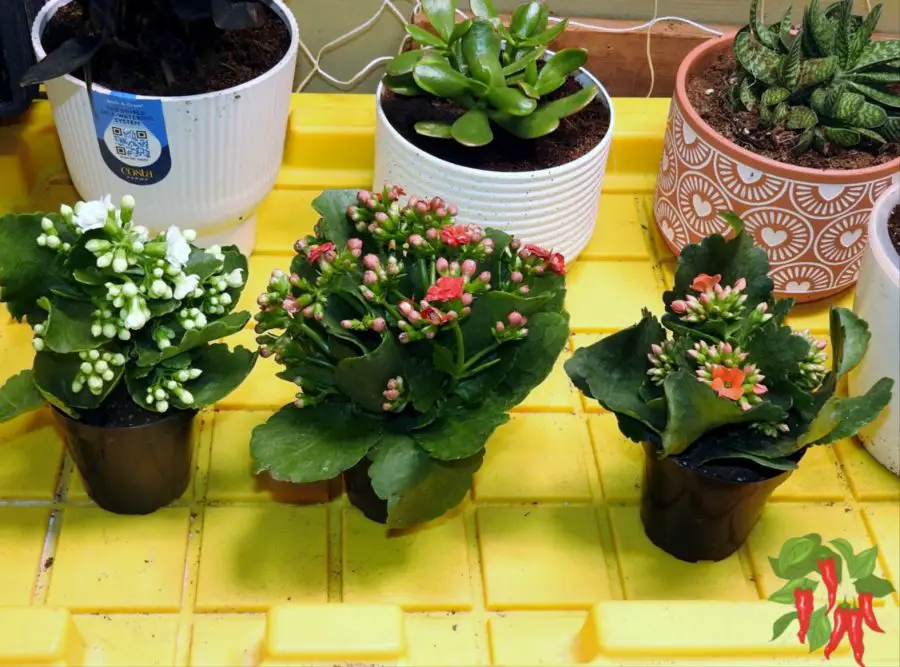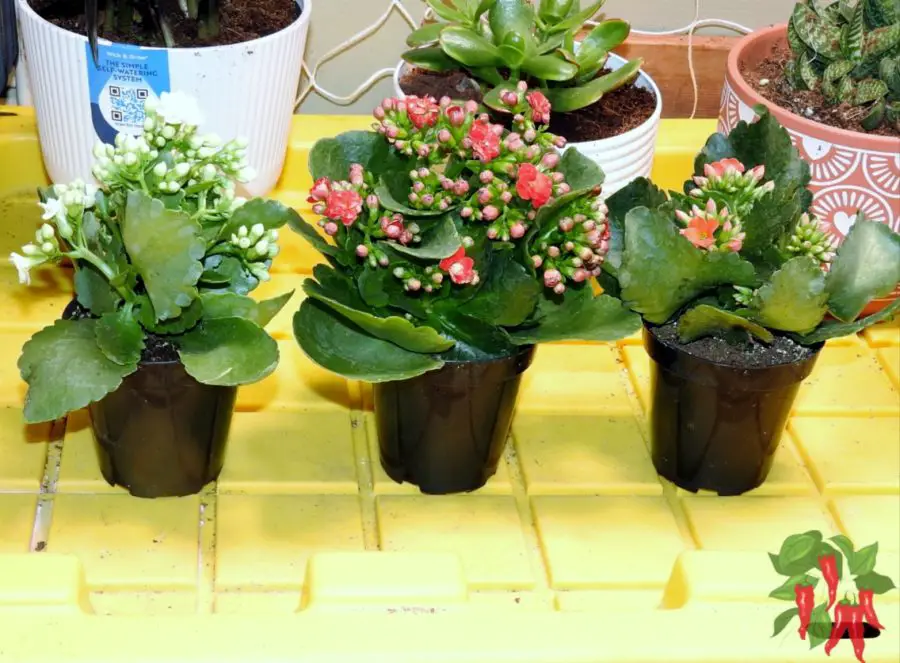This post may contain affiliate links. If you buy something from one of our links we may earn a commission. Thanks

Master Flaming Katy plant care with our easy guide. Learn simple tips for watering, light, and blooming success – perfect for beginners and experienced growers alike!
Flaming Katy Plant Care Key Takeaways
- Flaming Katy plant care requires bright indirect sunlight.
- Use well-draining soil and a pot with drainage holes.
- Water moderately when the top inch of the soil feels dry.
- Maintain temperatures between 60-75°F (15-24°C).
- Fertilize monthly during the growing season for optimal blooming.
- Water sparingly in winter and stop fertilizing.
Indoor Kalanchoe Success Tips Made Easy
 Kalanchoe Live Succulents Plants Live Flowers (3 Pack), Kalanchoe Plant Live Succulent Plants, Kalanchoe Plants Live Indoor Plants Live Houseplants, Fresh Flowers for Delivery Prime by Plants for Pets
Kalanchoe Live Succulents Plants Live Flowers (3 Pack), Kalanchoe Plant Live Succulent Plants, Kalanchoe Plants Live Indoor Plants Live Houseplants, Fresh Flowers for Delivery Prime by Plants for Pets
Growing indoor plants should be fun, and Flaming Katy plant care is easier than you might think.
While these colorful succulents sometimes get a reputation for being finicky about blooming, a few simple care tips will keep your Kalanchoe blossfeldiana thriving and flowering all year round.
Kalanchoe Plant Care Reference Guide
| Characteristic | Details |
|---|---|
| Common Name | Flaming Katy, Christmas Kalanchoe, Florist Kalanchoe |
| Botanical Name | Kalanchoe blossfeldiana |
| Native Habitat | Madagascar |
| Plant Type | Succulent |
| Growth Pattern | Upright, bushy, compact |
| Mature Size | 8-12 inches tall and wide |
| Watering | Allow the top inch of soil to dry between waterings; reduce in winter |
| Light/Sun Exposure | Bright, indirect light; morning sun ideal |
| Soil Type | Well-draining coco coir/perlite mix or succulent soil |
| Soil pH | 6.0-6.5 |
| Temperature | 60-75°F (15-24°C) |
| Humidity | Moderate to low; tolerates average home humidity |
| Bloom Time & Flower Color | Winter to spring; red, pink, orange, yellow, white |
| Potential Problems | Root rot from overwatering, mealybugs, powdery mildew, leaf drop |
| Repotting | Every 18-24 months in spring |
| Hardiness Zones (USDA) | 10-12 (grown as a houseplant in most regions) |
Flaming Katy Plant Care: Essential Tips for Indoor Success

Looking to add a burst of long-lasting color to your indoor space? Flaming Katy plant care offers just that. Get months of vibrant blooms with surprisingly minimal effort.
These cheerful succulents brighten any room with their clusters of jewel-toned flowers, and once you understand their basic needs, you’ll discover why they’re one of the most rewarding indoor plants to grow.
Understanding Your Flaming Katy
Let’s get to know your Flaming Katy better! These cheerful succulents (Kalanchoe blossfeldiana) with their clusters of tiny flowers in vibrant reds, pinks, oranges, and yellows, are actually part of the jade plant family.
Native to Madagascar, they’ve become incredibly popular houseplants because they can bloom for months with minimal care. Plus, they’re perfect for brightening up any room in your home.
 Kalanchoe Plant Succulents Plants Live Houseplants in White Planter, Live Succulents Live House Plants, Succulent Plants Live Plants Indoor Plants, Live Succulent Plant Lover Gifts by Plants for Pets
Kalanchoe Plant Succulents Plants Live Houseplants in White Planter, Live Succulents Live House Plants, Succulent Plants Live Plants Indoor Plants, Live Succulent Plant Lover Gifts by Plants for Pets
Light Requirements
Your Flaming Katy needs the right amount of light to thrive and produce those gorgeous blooms. Think of light as their morning coffee – they need it to get going!
These plants love bright, indirect sunlight. Too little light means fewer flowers, while too much direct sun can scorch their leaves. A sunny east or west-facing window is usually perfect.
• Place 2-3 feet from a bright window
• Protect from harsh afternoon sun
• Rotate the pot weekly for even growth
• Use sheer curtains to filter intense light
Watering Guidelines
Let’s talk about the most common question – when to water your Flaming Katy! These succulents are pretty forgiving, but they definitely don’t like wet feet.
Think of them as the Goldilocks of watering – not too much, not too little, but just right. The good news is, they’ll tell you when they’re thirsty by showing slightly droopy leaves.
• Water when the top inch of soil feels dry
• Allow excess water to drain completely
• Water less frequently in winter months
• Avoid getting water on leaves or flowers
Soil and Potting
Your Flaming Katy needs the right home to flourish, starting with proper soil and potting. Think of soil as their foundation.
It needs to be well-draining while still holding enough moisture for those thirsty roots.
The right pot and soil combination will keep your plant happy and prevent common problems like root rot.
• Use cactus/succulent potting mix
• Choose pots with drainage holes
• Add perlite for extra drainage
• Repot every 2 years in spring
Recommended Alternative Potting Mix
Creating your own soil mix for your Flaming Katy can be both cost-effective and beneficial for your plant. Here’s why coco coir and perlite make an excellent alternative to pre-made cactus mixes, and how to create the perfect blend.
Why Coco Coir and Perlite?
Coco coir and perlite provide excellent drainage while retaining just enough moisture for your Flaming Katy’s roots.
This combo helps prevent the dreaded root rot while keeping your plant hydrated – it’s like giving your plant the perfect balance between a drink and a dry spell.
Perfect Potting Mix Recipe
• Mix 3 parts coco coir to 1 part perlite
• Add compost or worm castings (optional)
• If using a coco brick rehydrate it and make sure it is broken up
• Thoroughly mix ingredients together
Benefits of This Mix
• Better drainage than standard potting soil
• Sustainable alternative to peat moss
• Resists compaction over time
• Naturally pest resistant
• Reusable and eco-friendly
• Better root development
• More control over moisture levels
This alternative mix provides excellent aeration and moisture control, helping your Flaming Katy establish a strong root system. Plus, it’s an environmentally conscious choice that your plant will love!
Pro Tips for Mix Success
Your Flaming Katy will thrive in this simple two-ingredient mix that provides the perfect balance of moisture retention and drainage.
The coco coir holds just enough water while the perlite ensures excellent aeration – exactly what your plant needs for healthy root growth.
Remember: Less is more when it comes to soil mixes. This simple combination works perfectly without the need for additional ingredients.
Temperature and Humidity
The good news is Flaming Katies are super adaptable to normal home temperatures! They’re comfortable in the same conditions we enjoy, making them perfect indoor companions.
However, they do have some preferences that’ll keep them blooming their best:
• Keep between 60-75°F (15-24°C)
• Protect from cold drafts
• Maintain moderate humidity
• Keep away from heating/AC vents
Fertilizing
Think of fertilizer as a healthy snack for your Flaming Katy. They don’t need much, but a little boost during their growing season can make a big difference.
Too much fertilizer can harm your plant, so let’s keep it simple and effective with these easy-to-follow guidelines.
• Feed monthly during growing season (spring/summer)
• Use balanced liquid fertilizer (20-20-20)
• Dilute fertilizer to half strength
• Skip fertilizing during winter months
Pruning and Maintenance
Regular grooming keeps your Flaming Katy looking its best and encourages more blooms. It’s kind of like getting a haircut!
Removing spent flowers keeps things tidy and tells your plant to produce more blooms. It’s like giving them a gentle nudge to keep the show going.
• Remove dead or faded flowers regularly
• Pinch back leggy stems
• Clean leaves with a damp cloth when dusty
• Trim damaged or yellowing leaves
Propagating Your Flaming Katy
Ever looked at your thriving Flaming Katy and wished you could have more? The good news is propagating these colorful succulents is easier than you think!
With a few simple steps, you can grow new plants from your existing one, whether it’s for expanding your collection or sharing with friends.
Stem Cutting Method
This is the most reliable way to get new plants. Here’s how to do it:
• Choose healthy stems 4-6 inches long
• Make clean cuts just below a leaf node
• Remove lower leaves, leaving 2-3 pairs at top
• Let cuttings dry for 24 hours to callus
• Dip ends in rooting hormone (optional)
Preparing for Success
• Use clean, sharp scissors or pruning shears
• Prepare small pots with well-draining soil mix
• Keep propagation area warm (65-75°F)
• Have spray bottle ready for light misting
Planting Your Cuttings
• Insert stems about 1-2 inches deep in soil
• Space multiple cuttings 2 inches apart
• Firm soil gently around stems
• Mist lightly to settle soil
Care During Rooting
• Keep the soil barely moist, not wet
• Place in bright, indirect light
• Avoid direct sun until established
• Look for new growth in 2-3 weeks
• Roots typically form in 3-4 weeks
Flaming Katy Pups: A Natural Way to Multiply

Yes, Flaming Katies can produce pups (offsets), though they’re less prolific than some other succulents.
These baby plants develop from the base of the mother plant offering an easy and natural way to propagate. Let’s explore how to identify, care for, and separate these little ones.
Identifying Pups
• Look for small shoots at the soil level
• Pups emerge from the plant’s base
• They share the mother plant’s root system
• Usually appear in spring/summer
• Look like miniature versions of the parent plant
When to Separate Pups
• Wait until pups are 2-3 inches tall
• Ensure they have their own roots
• Best done during growing season
• Look for at least 2-3 leaf sets
• Check for firm, healthy growth
Separation Process
• Water parent plant day before separation
• Gently remove from pot
• Clear soil around the pup’s base
• Look for natural separation point
• Use a clean, sharp knife if needed
• Keep roots intact when possible
Aftercare
• Plant pups in small pots
• Use well-draining succulent mix
• Keep soil slightly moist until established
• Place in bright, indirect light
• Hold off on fertilizing for the first month
Pro Tips
While Flaming Katies do produce pups, they’re not as prolific as plants like Aloe or Haworthia.
Healthy plants in optimal conditions are more likely to produce pups. Sometimes, stress or changes in growing conditions can trigger pup production.
Remember: Don’t force separation if pups seem firmly attached. It’s better to wait until they’re ready than risk damaging either plant. Patience is key for successful pup propagation!
Common Propagation Problems
• Rotting stems (too much moisture)
• Failed rooting (poor contact with soil)
• Slow growth (insufficient light)
• Wilting (too much direct sun)
Pro Tips for Success
Wait until spring or summer to propagate for the best results. Keep cuttings away from cold drafts and strong air currents.
Once new growth appears, treat your baby plants like mature ones, gradually increasing light exposure and beginning a regular watering routine.
Remember: Not every cutting will successfully root, so take a few more than you need.
The great thing about Flaming Katies is that taking cuttings actually encourages the parent plant to grow bushier, so it’s a win-win situation!
Signs of Success
• New leaf growth at stem tips
• Firm, upright stems
• Resistance when gently tugged
• Visible root development at the soil surface
With a little patience and these simple steps, you’ll be well on your way to expanding your Flaming Katy collection.
It’s incredibly rewarding to watch your cuttings develop into full-grown plants with their own beautiful blooms!
Common Problems
Even the happiest Flaming Katies can face challenges, but don’t worry – most issues are easy to fix once you know what to look for.
Being able to spot problems early makes solving them much easier. Here’s what to watch for and how to handle it.
• Yellowing leaves often mean overwatering
• Dropping buds indicate temperature stress
• Brown leaf spots suggest sunburn
• Leggy growth means insufficient light
Indoor Kalanchoe Success Tips FAQs

You’ve got questions? We’ve got answers! Here are the most common things folks ask about their Flaming Katies, answered in plain English.
Q: Why won’t my Flaming Katy bloom?
A: Usually, it needs more light or is getting too much water. Try moving it to a brighter spot and letting the soil dry between waterings.
Q: How long do the flowers last?
A: With proper care, blooms can last 2-6 months!
Q: Can I put my Flaming Katy outside?
A: Yes, but only when temperatures are between 60-75°F (15-24°C) and in partial shade.
Flaming Katy Plant Care Conclusion

Kalanchoe Flower Plants 3PK, Desk Plant Decor, Live Succulent Gifts for Plant Lovers Gift Ideas, Kalanchoe Plants Live Houseplants Live Indoor, Live Succulents Plants Live Flowers by Plants for Pets
Caring for a Flaming Katy can bring months of colorful joy to your space. By following these simple guidelines, you’ll be well on your way to becoming an expert at growing these cheerful bloomers.
Remember, every plant is unique, so don’t be afraid to adjust these tips to what works best in your home.
Related Care Topics
Getting More Blooms
Want to encourage more flowers? Try giving your plant complete darkness for 14 hours a day for six weeks during the fall. This mimics their natural blooming cycle and often triggers a fresh burst of flowers.
Propagation Success
Love your Flaming Katy so much you want more? Take stem cuttings in spring or summer, let them callus over for a day, then plant in well-draining soil. Keep slightly moist until roots develop.
Seasonal Adjustments
Adjust care slightly with the seasons – less water in winter, more light in darker months, and reduced fertilizer during dormancy periods.
Key Takeaways
• Water only when the top inch of soil is dry
• Bright, indirect light is crucial for blooming
• Regular deadheading encourages more flowers
• Keep away from cold drafts and hot air vents
• Feed monthly during the growing season only
• Watch for signs of overwatering – the biggest threat
• Most problems are easily fixed by adjusting water or light
Growing Success Tips
The secret to a happy Flaming Katy is observation. Check your plant regularly, adjust care based on how it responds, and don’t be afraid to make changes if something isn’t working.
With a little attention and these care basics, your Flaming Katy will reward you with waves of beautiful blooms throughout the year.
Remember: The best part about growing these delightful plants is that they’re quite forgiving. If you make a mistake, they’ll usually bounce back quickly once you correct the issue. Happy growing!
Learn more: Indoor Apartment Gardening: 15 Point Comprehensive Guide






